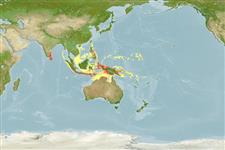Élasmobranches (requins et raies) (sharks and rays) >
Carcharhiniformes (Ground sharks) >
Atelomycteridae (Coloured catsharks)
Etymology: Atelomycterus: ateles (Gr.), imperfect, unfilled or exempt; mycteros (Gr.), nostril, referring to lack of posterior nasal valve. (See ETYFish); baliensis: -ensis, Latin suffix denoting place: Bali, Indonesia, only known area of occurrence. (See ETYFish).
More on authors: White, Last & Dharmadi.
Environment: milieu / climate zone / depth range / distribution range
Écologie
marin démersal. Tropical
Western Pacific: known only from the Indonesian island of Bali.
Taille / Poids / Âge
Maturity: Lm ? range ? - ? cm
Max length : 47.4 cm TL mâle / non sexé; (Ref. 54850)
Description synthétique
Morphologie | Morphométrie
A relatively small (max. size 474 mm TL) Atelomycterus with the following combination of characters: relatively short preoral length, 4.0-4.6% T; short interdorsal space, 11.6-12.9% TL; high pectoral-pelvic to pelvic-anal ratio 1.28-1.48; dorsal fins weakly falcate, with posterior margins vertical or sloping anteroventrally from fin apices; prebranchial denticles strongly tricuspid with narrow, elongate medial cusps; claspers of adults short, not stubby, not tapering sharply distally, outer length 8.3-9% TL, base width 5.4-6.3% of outer length; clasper glans covering more than half of clasper; cover rhipidion relatively narrow; rhipidion large, relatively low, and only partly concealed by cover rhipidion and exorhipidion; exorhipidion small with proximal end well behind distal end of cover rhipidion; total vertebral centra 154-163, precaudal centra 101-106; dorsal surface with well-defined dark saddles consisting mainly of four, partly coalesced, diffuse-edged, dark brown blotches; white partly coalesced, diffuse-edged, dark brown blotches; white spots absent from body and rarely on fins; inner margin of pale tips of dorsal fins orientated almost vertically; upper pectoral fin lacking a broad, sharply defined whitish margin.
Biology unknown; presumably reef-dwelling, inhabiting holes and crevices on reefs, like other related catsharks. Presumably oviparous. Diet probably dominated by small invertebrates . Caught irregularly by fisheries operating over coral reefs. Utilized for its meat but of limited value (Ref.58048).
Life cycle and mating behavior
Maturité | Reproduction | Frai | Œufs | Fécondité | Larves
White, W.T., P.R. Last and Dharmadi, 2005. Description of a new species of catshark, Atelomycterus baliensis (Carcharhiniformes: Scyliorhinidae) from eastern Indonesia. Cybium 29(1):33-40. (Ref. 54850)
Statut dans la liste rouge de l'IUCN (Ref. 130435)
Menace pour l'homme
Harmless
Utilisations par l'homme
Plus d'informations
PaysZones FAOÉcosystèmesOccurrencesIntroductionsStocksÉcologieRégime alimentaireÉléments du régime alimentaireConsommation alimentaireRation
Noms communsSynonymesMétabolismePrédateursÉcotoxicologieReproductionMaturitéFraiRassemblement de ponteFéconditéŒufsDéveloppement de l'œuf
Taille/ÂgeCroissanceLongueur-poidsLongueur-longueurFréquences de longueursMorphométrieMorphologieLarvesDynamique des populations larvairesRecrutementAbondanceBRUVS
RéférencesAquacultureProfil d'aquacultureSouchesGénétiqueElectrophoresesHéritabilitéPathologiesTraitementNutrientsMass conversion
CollaborateursImagesStamps, Coins Misc.SonsCiguateraVitesseType de nageSurface branchialeOtolithesCerveauxVision
Outils
Articles particuliers
Télécharger en XML
Sources Internet
Estimates based on models
Phylogenetic diversity index (Ref.
82804): PD
50 = 0.5156 [Uniqueness, from 0.5 = low to 2.0 = high].
Niveau trophique (Ref.
69278): 3.7 ±0.3 se; based on size and trophs of closest relatives
Résilience (Ref.
120179): Faible, temps minimum de doublement de population : 4,5 à 14 années (Low fecundity (RF)).
Fishing Vulnerability (Ref.
59153): Moderate vulnerability (37 of 100).
